At 49, Padma Lakshmi Is Stronger Now Than She’s Ever Been

To hear Padma Lakshmi recount the last restaurant meal she ate before lockdown is an almost spiritual experience. It was lunch at the French café La Mercerie in New York’s SoHo neighborhood. Padma’s a creature of habit, she tells me, so she ordered the same thing she always does.
“They have a poached egg that sits in a cauliflower puree that is so decadent and divine,” she says. “But you feel virtuous because it’s literally one egg. The portion is small, but you know it’s rich, especially if you’re eating a kilo of bread next.” (For the record, she slathers that kilo of bread with the restaurant’s signature flavored butters, varieties like lemon and buckwheat.) “I also love their green salad. It’s so beautifully dressed—I’m against overdressing salads, putting a lot of heavy, creamy, cheesy things on them.”
While buckwheat butters and saucy eggs may have to wait a bit, the cookbook author and executive producer and host of Top Chef and Taste the Nation has hardly resorted to boxed mac ’n’ cheese or Top Ramen during self-isolation. In fact, Padma has found that her casual approach to cooking—dishes like roasted fennel salad and fish curry, which she’s been sharing via her popular Instagram videos—is particularly well-suited for this moment.
“I’m very fluid with my cooking. I’m not a formally trained chef,” she says. “But because I’ve been judging people for over a dozen years on television, I was afraid people wouldn’t be down with me doing this kind of ad hoc cooking [in my videos]. I’ll say, ‘Normally we use red onions in this, but I’m using shallots because that’s all I have,’ and I think that’s useful information for viewers.
“The professional food world is dominated by men,” she continues. “But most of the actual cooking of food in the world is done by women. And we women have always had to make do with whatever we can. We’re a little bit like water—we find our way because we’ve had to.”
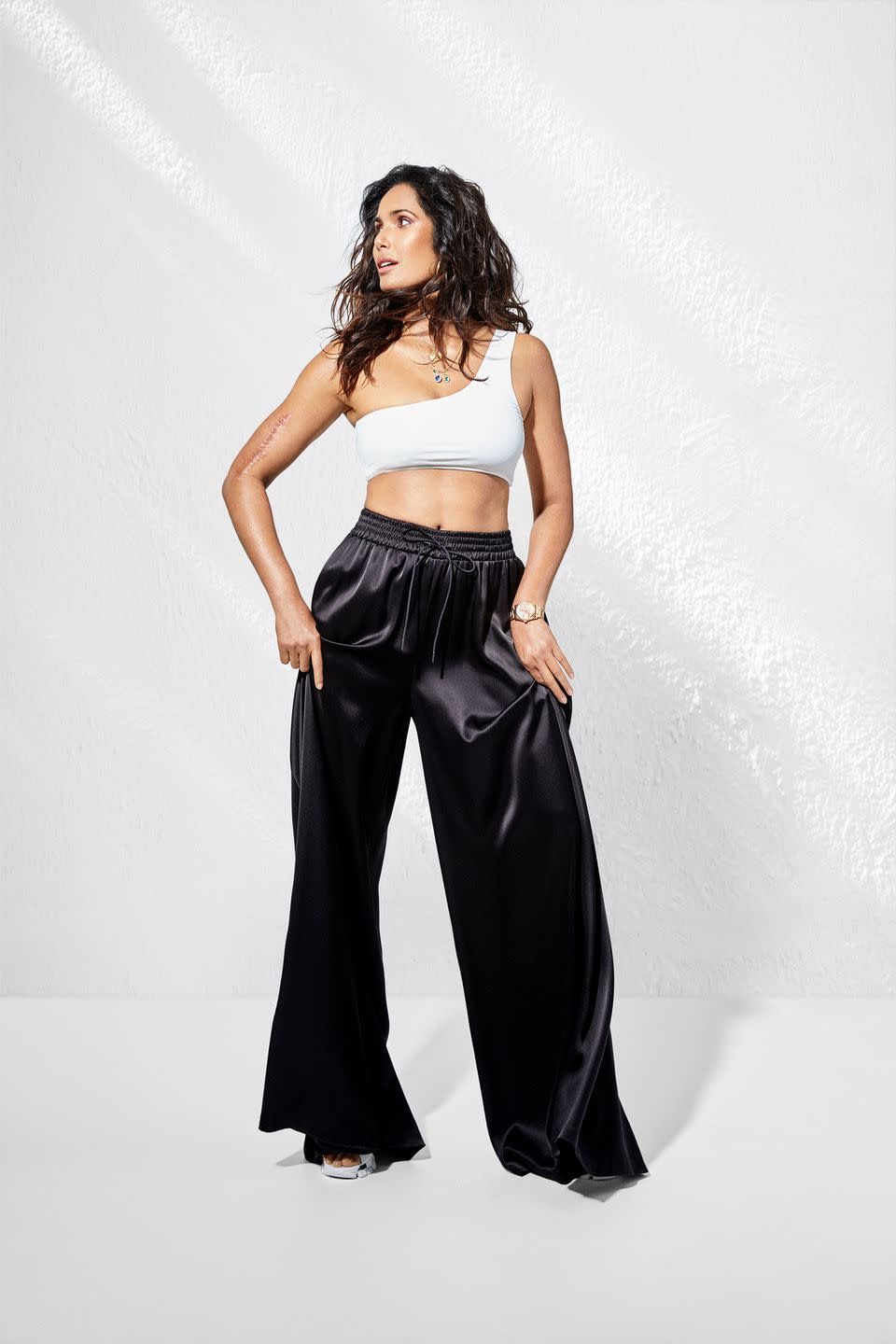
Finding her way in the food world is what helped land Padma her break. Born in India and raised in New York and L.A., she spent the years after college working as a model and an actress. Her first movie role necessitated she gain 20 pounds, and afterward, Padma wanted to get back to her pre-movie size while cooking the recipes she loved. She refashioned those dishes into low-fat versions (this was the ’90s, when fat was the enemy), and Easy Exotic: A Model’s Low-Fat Recipes From Around the World was born.
To be sure, Padma’s version of healthy has evolved over the years. Nowadays, she likes to split her plate into halves: 50 percent fruits and vegetables; 50 percent simple carbs, starch, and lean protein. While she tries to eat largely plant-based when she’s not filming, she does allow herself some chicken, fish, ground turkey, and veal, with the occasional slice of bacon thrown in. (Her devotion to leafy greens is evident today: She’s clad in an emerald-hued tee that reads “More Vegetables.”)
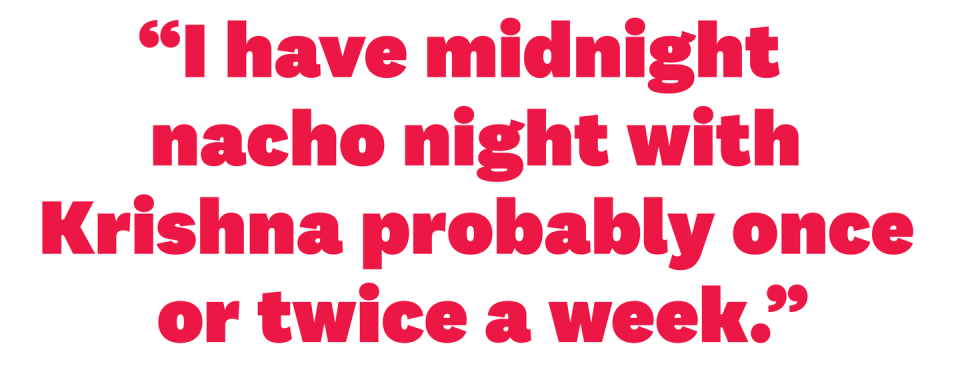
The 49-year-old starts each morning with a cup of “very strong” masala chai. She drinks 7 to 10 cups a day, and though she recently stopped doctoring her tea with sugar and honey, she still enjoys a splash of milk. For breakfast, she eats a cup of cottage cheese with a toasted English muffin and almost a whole pint of blackberries or blueberries. (Gotta get that 50 percent somehow!) If she’s craving something richer, she’ll opt for an egg-in-a-hole topped with pickled jalapeños or hot sauce. For lunch, she often eats leftovers from the night before. “We cook one fresh meal a day in our home, and that’s usually dinner,” she says. “I purposely cook extra so I will have enough for lunch.”
Around 4:00, Padma prepares a snack of apples and peanut butter or tomatoes and chips for her 10-year-old daughter, Krishna. “I’ll probably eat at least half that plate because it’s just sitting there,” she says. Dinner’s between 6:30 and 8:00—a lasagna, perhaps, or lentils and rice in a sautéed vegetable curry with yogurt raita. Padma isn’t big on desserts (she indulges in a hunk of chilled dark chocolate from time to time) but does admit to being a nighttime snacker. “I have midnight nacho night with Krishna probably once or twice a week,” she says.
This is all, of course, when she’s not in production on Top Chef, which aired its 17th season this spring. While working on the Bravo competition series, Padma may sample and judge more than 30 dishes an episode at the start of the season, eating upward of 7,000 to 8,000 calories a day. She’s long been open about her fluctuating weight during taping, but more recently she’s been focusing on how these periods of plenty affect her overall health. A few years ago, at the urging of a relative in the medical field who reminded her that diabetes runs in their family, she enlisted a doctor to monitor her weight and blood work before and after each season.
“My parents are diabetic,” she says. And though Padma isn’t, her doc did prescribe a preventive medication to regulate blood-sugar levels while she’s filming. “Those chefs are cooking to win, so they’re putting in as much lard and butter and salt as they can.”
Once she’s packed up and gone home, Padma returns to her regularly scheduled programming of mindful eating, but it’s exercise, she says, that does the heavy lifting in getting her body to where she wants it to be.
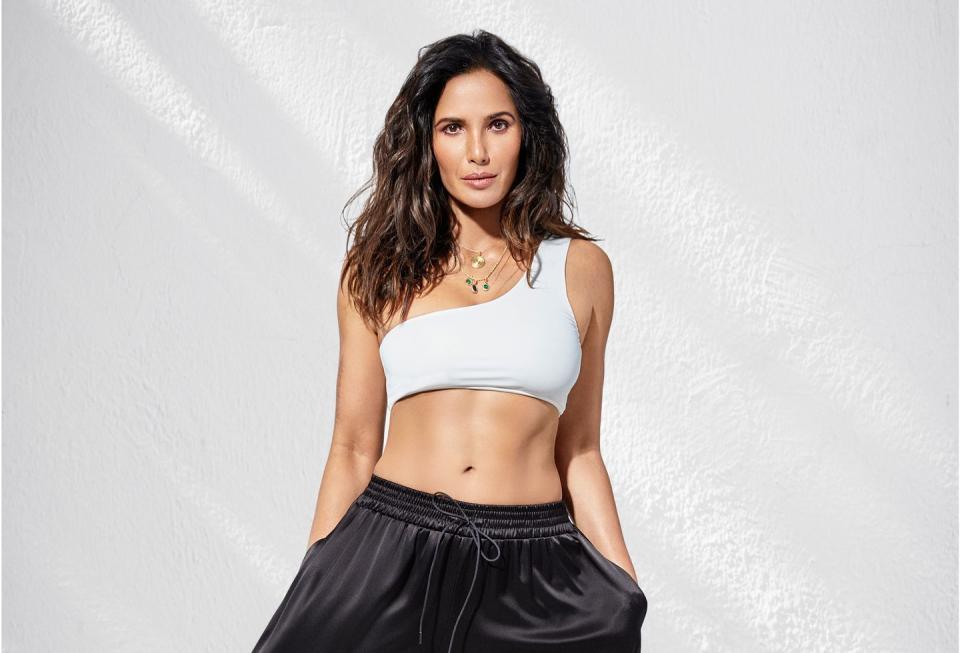
Ideally, she works out at least five times a week for 90 minutes, but like most of us, she’s had to tweak her routine with gyms and studios closed. Her primary cardio is now jumping rope. She does 2,000 strokes every day, which takes about 35 minutes. (FYI, she stops after every 100 strokes to take a water break.) When it comes to strength, she FaceTimes her Pilates instructor from The Space for twice-weekly mat sessions.
“I started going to Pilates a few years ago, because my chiropractor recommended it for my back,” says Padma, who was diagnosed with scoliosis at the age of 13, then fractured her hip and shattered her arm in a car accident when she was 14. “Pilates changed my body. It made me strong in places I didn’t know I needed to be. I have a butt now that I didn’t have during my modeling career!”
She also added physical therapy sessions due to a recent back injury. She’s initially sheepish about revealing the particulars but admits one of those Instagram popular posture correctors is to blame. She was wearing the corrector for long hours while sitting and writing and the compression on her spine actually resulted in a herniated disc.
A post shared by Padma Lakshmi (@padmalakshmi) on Dec 30, 2019 at 12:48pm PST
Pre-COVID-19, Padma protected her back by working with her trainer Tony to safely lift weights—your classic squats, lunges, and dumbbell curls—two or three times a week at her local New York Sports Club. (It’s refreshingly anti-celeb to hear Padma sing the praises of her neighborhood gym.)
“He’s there to watch my form, and he spends most of his time telling me not to do something,” she says. After an hour with Tony, Padma continued on her own with 30 minutes of cardio on the elliptical, treadmill, or slide board (that slick mat that mimics speed skating). On alternate days, she’d hit the ring with her coach Dell at Mendez Boxing for an hour, and once “all warm,” head to The Space for spine-friendly reformer work.

For Padma, pain management has been something of a theme in life. In addition to scoliosis and the car accident, she started getting excruciating cramps when she was a teen. Because of her mom’s similar history, Padma never questioned it; painful periods were just part of a woman’s life, she reasoned. It wasn’t until she was 36 years old that she was diagnosed with endometriosis, a condition in which tissue similar to that which lines the uterus begins growing on the outside of it. Padma’s stage 4 endo necessi-tated laparoscopic excision surgery to remove the invasive tissue.
“At first, I was relieved,” Padma recalls of the weeks following the procedure. “It wasn’t until a year after the surgery that I started getting really pissed. Like, ‘Wait a minute, I lost a week of my life every month of every year since I was 13 because of this shit, and I could have had this operation at 20 rather than 36?’ I’m shocked that a health professional didn’t say, ‘This is weird. Your cramps are above and beyond what they should be.’ ”
That anger spurred Padma to cofound the Endometriosis Foundation of America alongside her endometriosis specialist Tamer Seckin, MD. The foundation works to bring awareness of the disease and in 2009 partnered with Massachusetts Institute of Technology to launch a gynepathology research facility, the first of its kind, devoted solely to investigating women’s reproductive issues, including endometriosis, uterine fibroids, and polycystic ovarian syndrome.
The foundation is one of a handful of advocacy projects Padma champions. She’s also an ambassador for the American Civil Liberties Union and is working with the James Beard Foundation on its pandemic restaurant-relief efforts. Padma fears for the future of her favorite restaurants—both the high-profile spots that operate on surprisingly tight margins and the smaller local joints she featured on the first season of her Hulu food show Taste the Nation, which explores the immigrant roots of American cuisine.
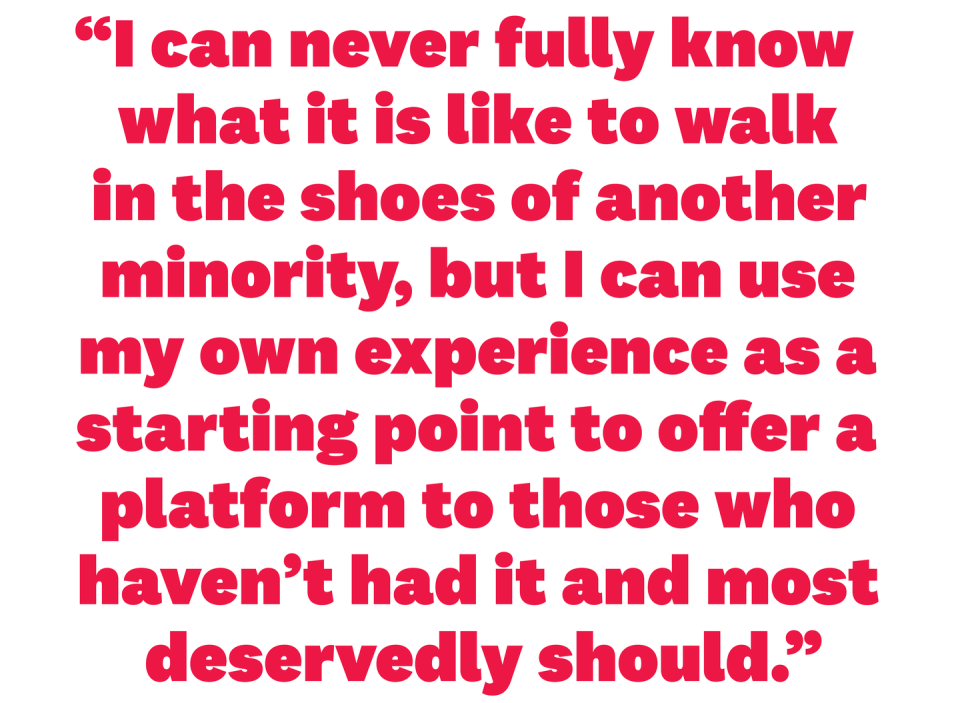
The concept for her new show came to Padma after the 2016 election, when immigration rights were under attack. “I was always self-referring to my own immigrant story, and I kind of got sick of talking about myself,” says Padma. “I started trying to find and understand the stories of other immigrants, to prove my political points. Taste the Nation is about exploring American food and how it evolves, and using food to get into a community. Because for so many of us in America, other people are deciding our narrative. Other people are telling our story in a more amplified way than we’re able to because we all don’t have access to that megaphone.”
Padma has also been using that powerful megaphone of hers—social media, specifically—to help amplify the voices of Black Lives Matter, whether through sharing an inspiring message or calling out racism in the food industry.
“I can never fully know what it is like to walk in the shoes of another minority, but I can use my own experience as a starting point to offer a platform to those who haven’t had it and most deservedly should,” she says. “The only good that can come from this period of deep struggle and pain in America is a greater understanding of each other. We need every voice to play a part in making our country more inclusive.”
A greater appreciation for and understanding of the cultures that shape us is something Padma is working to instill in her daughter, who is half white and half Indian. “I’m trying to think through the practice of cooking with Krishna,” says Padma, who is writing a children’s book loosely based on this idea. “I want to pass down more than just heritage and culture—also how to live ethically, and be kind and fair and detail-oriented. There are metaphors for life that you can find in the act of cooking.”
It’s clear that for Padma, food isn’t just about sustenance. It’s about vitality. And joy. And love. And power. It helps us understand the world around us, while making that world just a bit smaller and easier to digest. And that might be the healthiest food philosophy we’ve heard yet.
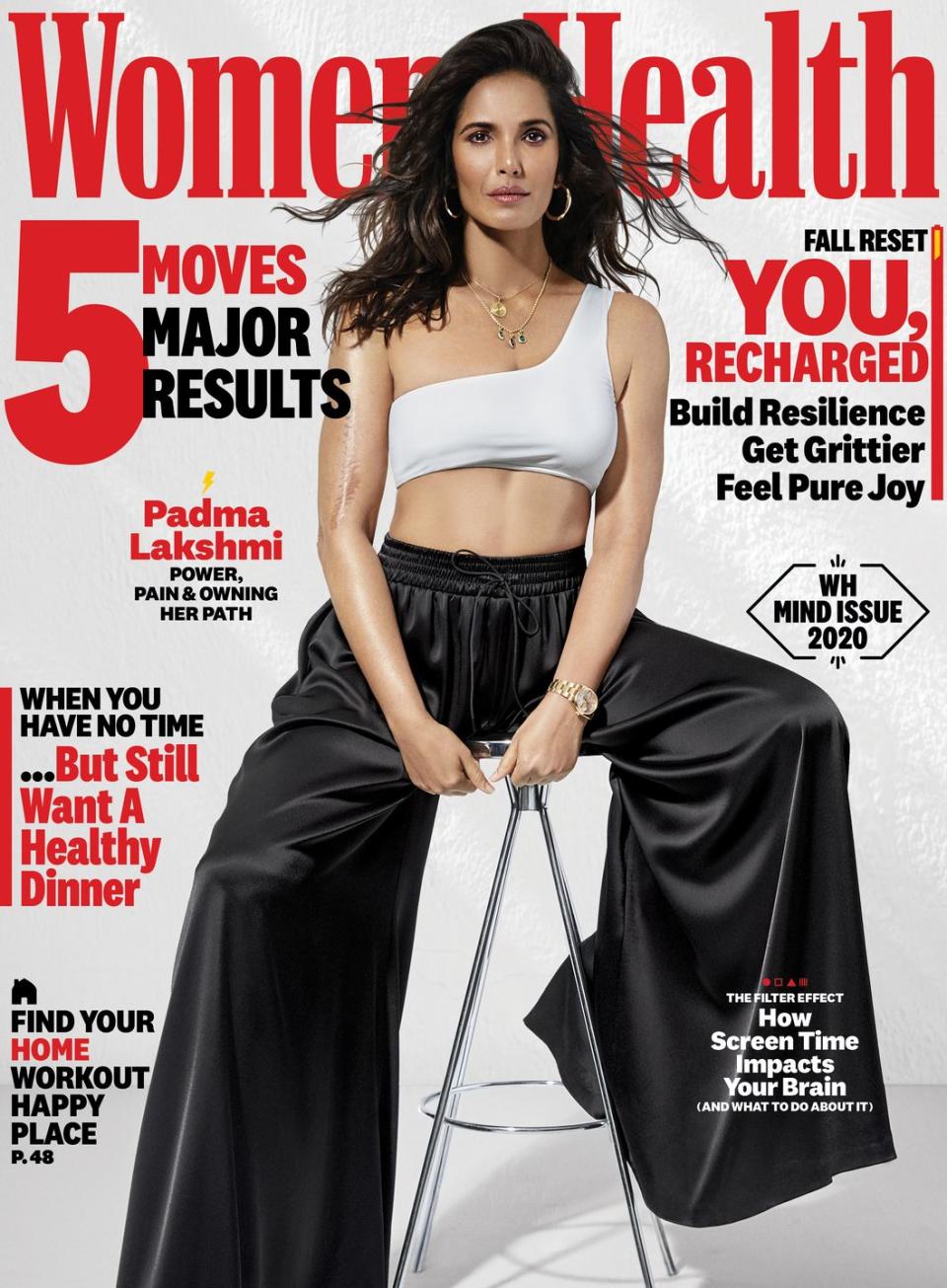
Photographed by Tyler Joe Styled by Ann Wang Hair: Jeanie Syfu/Atelier Management Makeup: Bob Scott/The Wall Group
This article appears in the September 2020 issue of Women’s Health. Become a WH Stronger member now.
You Might Also Like

